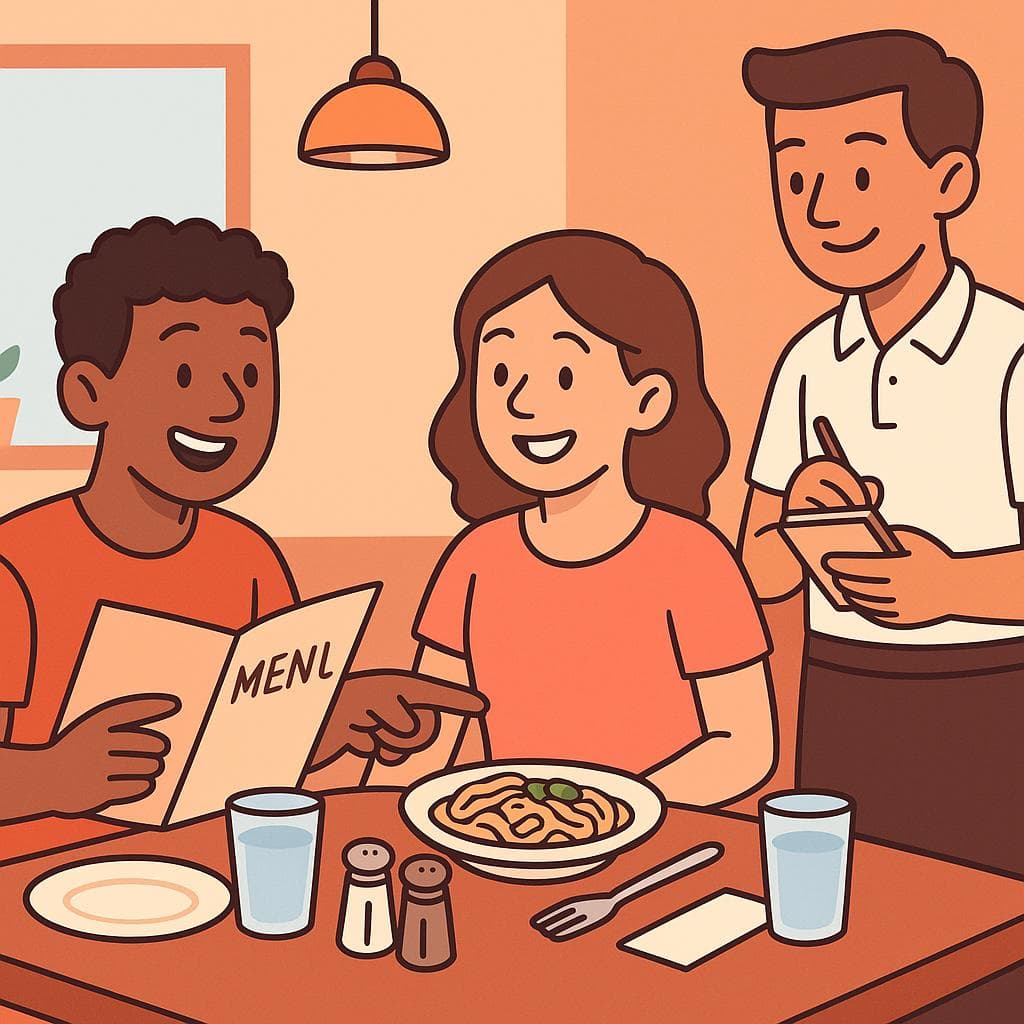I'll have the same
in SpanishPara mí, lo mismo
/pah-rah MEE, loh MEES-moh/
The most natural and versatile way to order what someone else just ordered. It literally translates to 'For me, the same.'

Using 'Lo mismo' is the easiest way to tell the waiter you want exactly what your friend is having.
💬Other Ways to Say It
Lo mismo, por favor
/loh MEES-moh, por fah-VOR/
A polite and simple standard version. Dropping the 'I will have' entirely makes you sound more like a native speaker.
Yo quiero lo mismo
/yoh KYEH-roh loh MEES-moh/
Literally 'I want the same.' While 'I want' sounds demanding in English, it is perfectly normal and polite in Spanish dining contexts.
Yo igual
/yoh ee-GWAL/
Literally 'Me equal' or 'Me the same.' Short, punchy, and very common in casual settings.
Tomaré lo mismo
/toh-mah-REH loh MEES-moh/
Uses the verb 'tomar' (to take/drink/eat). Closer to the English structure 'I will take the same.'
Me gustaría lo mismo
/meh goos-tah-REE-ah loh MEES-moh/
Literally 'I would like the same.' This is the 'safe' option if you are worried about politeness.
Me pones lo mismo
/meh POH-nehs loh MEES-moh/
Literally 'Put me the same.' Sounds aggressive to English speakers, but is very common and friendly in Spanish bars.
🔑Key Words
Key Words to learn:
📊Quick Comparison
Choose the right phrase based on who you are eating with.
| Phrase | Formality | Best For | Avoid When |
|---|---|---|---|
| Para mí, lo mismo | Neutral | Almost every situation | N/A (It's very safe) |
| Yo igual | Casual | Friends, bars, street food | Very formal business dinners |
| Me gustaría lo mismo | Formal/Polite | First dates, impressing in-laws | Ordering a cheap beer at a dive bar |
📈Difficulty Level
Very easy. No difficult rolling Rs. Just watch the vowel sounds in 'mismo' (MEES-moh).
You can avoid verbs entirely by using 'Para mí' (For me).
The only challenge is getting used to being more direct than in English.
Key Challenges:
- Stopping yourself from translating 'I will have' literally
💡Examples in Action
—Yo quiero una margarita. —Para mí, lo mismo, por favor.
—I want a margarita. —I'll have the same, please.
El caballero pidió el filete. Yo tomaré lo mismo.
The gentleman ordered the steak. I will take the same.
¿Vas a pedir tacos al pastor? ¡Yo igual!
Are you going to order al pastor tacos? Same here!
🌍Cultural Context
Directness in Dining
English speakers often use 'I'll have' or 'Could I please get' to soften a request. Spanish speakers are much more direct. Saying 'Quiero lo mismo' (I want the same) isn't rude—it's efficient. Politeness is conveyed through tone of voice and a smile rather than extra words.
The 'Tapas' Factor
In Spain and parts of Latin America, dining is often 'family style' or shared plates (tapas/raciones). In these contexts, you wouldn't say 'I'll have the same' because everyone is eating from the middle! You would only use this phrase for your individual drink or main course.
Getting the Waiter's Attention
Before you can order 'lo mismo,' you need the waiter's attention. In Latin America, a subtle hand raise or 'Joven' (young man) works. In Spain, you might hear a loud '¡Oiga!' or '¡Perdona!' Don't be shy—waiting quietly often means waiting forever.
❌ Common Pitfalls
Using 'Tener' (To Have)
Mistake: "Saying 'Tendré lo mismo' to mean 'I will have the same.'"
Correction: Tomaré lo mismo / Para mí lo mismo
Gender Confusion
Mistake: "Saying 'La misma' when referring to food in general."
Correction: Lo mismo
💡Pro Tips
The Point-and-Click Method
If you forget the words, a polite smile, a nod towards your companion, and saying 'Para mí también' (For me too) works perfectly 100% of the time.
Ordering Rounds
If you are ordering a second round of drinks, you can say 'Otra ronda, igual' (Another round, the same) to repeat the entire previous order for the table.
🗺️Regional Variations
Spain
Spain's service culture is fast and direct. Using 'Me pones' (literally: put me) is very common in bars and cafeterias and implies friendliness, not rudeness.
Mexico
Mexicans are generally very polite. While 'Yo igual' is common among friends, adding 'por favor' at the end is always appreciated here.
Argentina
In Argentina, you might hear 'Yo también' (Me too) used frequently as a way to order the same thing effectively.
💬What Comes Next?
The waiter asks if you want the exact same sides/options
¿Con todo igual?
With everything the same?
Sí, todo igual, gracias.
Yes, everything the same, thanks.
You want the same drink but a different size
¿Grande o chica?
Large or small?
Grande, por favor.
Large, please.
🔄How It Differs from English
The biggest difference is the verb choice. English uses the future tense 'I will have.' Spanish prefers the present tense 'I want' (Quiero) or prepositional phrases 'For me' (Para mí). Spanish focuses on the desire or the recipient, whereas English focuses on the future acquisition.
False Friends & Common Confusions:
Why it's different: Translating this as 'Tendré' (I will have/possess) sounds like you are predicting you will own the food in the future, not asking to eat it now.
Use instead: Quiero... (I want) or Voy a pedir... (I'm going to order)
🎯Your Learning Path
➡️ Learn Next:
How to ask for the bill in Spanish
Once you've ordered and eaten, you'll need to pay.
How to say delicious in Spanish
To compliment the food you just ordered.
How to order a beer in Spanish
Specific vocabulary for the most common drink order.
✏️Test Your Knowledge
💡 Quick Quiz: I'll have the same
Question 1 of 3
You are at a casual taco stand with a friend. Your friend orders three tacos. What is the most natural, short way to say you want the same?
Frequently Asked Questions
Can I just say 'Yo también' (Me too)?
Yes, absolutely! While 'Yo también' technically means 'Me too,' in the context of ordering after someone else, the waiter will perfectly understand that you want the same order.
Is it rude to say 'Quiero' (I want)?
Not usually. In English, 'I want' sounds like a demanding toddler. In Spanish, 'Quiero' is a standard, neutral way to state your preference to a waiter. If you're worried, just add 'por favor' at the end.
What if I want the same food but a different drink?
You can combine phrases! You could say: 'Para comer, lo mismo, pero para beber, una coca-cola' (To eat, the same, but to drink, a coke).
Do I say 'lo mismo' or 'la misma'?
Stick with 'lo mismo' (neutral) 90% of the time. Use 'la misma' only if you are referring to a specific feminine word you just said, like 'una cerveza... y para mí la misma' (a beer... and for me the same [beer]).
📚Continue Learning Spanish Phrases
Explore More Phrases in These Categories
Find similar phrases to expand your Spanish vocabulary:
Want to Learn More Spanish Phrases?
Browse our complete collection of Spanish phrases organized by situation, from basic greetings to advanced conversations. Perfect for travelers, students, and anyone learning Spanish.
View All Spanish Phrases →


.jpg&w=256&q=75)